Personal Capital Review: Powerful and Free Money Tools

This article may contain references to some of our advertising partners. Should you click on these links, we may be compensated. For more about our advertising policies, read our full disclosure statement here.
Personal Capital is a wealth management company who also offers a powerful suite of free money tools. Thankfully, these tools aren’t just for clients. Personal Capital’s financial tools are available to everybody, allowing you to see a complete picture of your financial situation all in one place.
Over the last several years, we’ve tried several wealth management and financial tracking tools. In our opinion, Personal Capital provides the best free tools for tracking your investments.
There are no gimmicks or fine print to worry about. Signing up for an account is easy, and you’re under no obligation to purchase anything from the company. Use of the tools is always free, making them our favorite alternative to Quicken and other “pay to play” tools.
Want to know how Personal Capital can help you? You’re in the right place.
The following Personal Capital review provides a detailed explanation of each tool, describes how we use them, and offers tips for how you can make the most of the free tools that are available. We’ve even updated the review for 2021, so you have the most current information on Personal Capital available.
Track Your Financial Goals for Free – Use Personal Capital’s free financial tools to track your finances and reach your goals. Track your investments, understand your cash flow, and plan for your future – and do it all in one place for free! Get started here.
Personal Capital at a Glance
- Digital wealth management services
- Free money tools available to everyone
- Founded in 2009
- Over 2.9 million registered tools users*
- 27,600 investment clients*
- Over $18.9 billion in assets under management*
*As of April 30, 2021
Personal Capital Top Features
- Net Worth Calculator
- Retirement Planner
- Savings Planner
- Investment Checkup Tool
- Investment Fee Analyzer
- Cash Flow Tool
- AES-256 Bank Level Encryption
What Is Personal Capital?

If you’re new to Personal Capital, it helps to think of the company as two separate units – free financial tools on one side and wealth management services on the other. This Personal Capital review focuses mainly on their financial tools, however, we’ll also provide a quick summary of their wealth management services.
As we’ve mentioned, Personal Capital offers a robust suite of free financial tools to anybody who registers with a free account. The tools provide various insights into your investments and overall financial standing. We’ll cover each of these tools in more depth below.
Additionally, the company offers fee-based wealth management services to investors. You are under no obligation to sign up for these services, even if you use their free tools.
The company was founded in 2009. On the investing side, Personal Capital now claims $18.9 billion in assets under management while more than 2.9 million users have registered to use their financial tools (as of April 30, 2021). They also use AES-256 encryption and require you to register each device you plan to use with your account.
Personal Capital’s Free Financial Tools
If you haven’t started using Personal Capital’s free money tools, we think you’re missing out. This free financial software helps you track your spending, analyze your retirement portfolio, track your net worth, and more.
Frankly, we think they are the best free financial tools around. The are more powerful than most free programs, making Personal Capital one of the best alternatives to Mint and other competitors.
Best of all, there’s no obligation for you to buy anything. Simply link your information and track all your accounts in one place.
We have used Personal Capital for years. We love it and we think you will too. Here is an in-depth look at their free financial tools.
The Dashboard
The Personal Capital dashboard provides a snapshot all of your financial accounts in one place, making it one of the most powerful features these tools offer. Better yet, you see it immediately upon logging in.
On the Personal Capital dashboard, you’ll find balances for all of your linked bank accounts, a list of your current investments and their balances, as well as a snapshot of your monthly cash flow. You can also check out your current net worth on an easy to read graph.
Here’s a quick peek at what you’ll find:
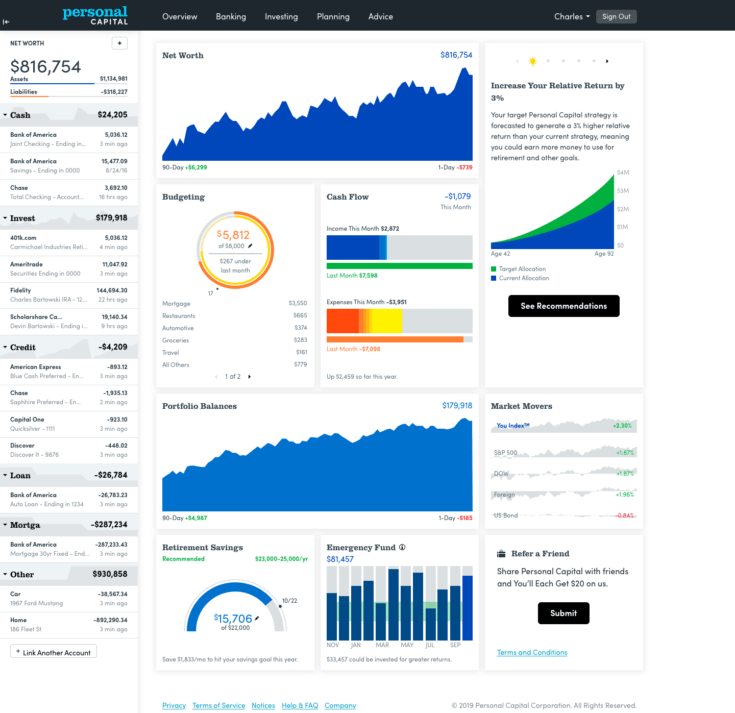
How We Use It: Of course, the dashboard is the first thing we see each time we log into our account. It allows us to quickly see if there’s been any major changes to our financial standing. We simply check out what’s been happening on the dashboard, then move on to the other tools for more in-depth info.
Net Worth Calculator
In our opinion, your “net worth” is the most important financial number you can track. In fact, it’s the best metric for measuring whether you’re winning with money over the long-term, and it’s a number that everybody who is serious about their finances should know.
In a nutshell, net worth measures the worth of your assets versus the amount of debt you owe at any given time. So, tracking and comparing your net worth over time provides a ton of insight into whether you’re financial situation is moving in the right direction.
The free financial tools at Personal Capital make tracking your net worth a breeze. Just link all of your asset accounts (banks, investments, etc.) with your liabilities (mortgage, student loans, car loans, credit card debt, etc.) and – voila! – Personal Capital does the math for you. You can even see your number directly from the dashboard.
By using the software, you can easily track your financial progress from month to month. Once you link your accounts, transactions are recorded on your Personal Capital account almost instantaneously. So, you can even track your numbers daily, if you’d like.
Here’s a screenshot of what this looks like:
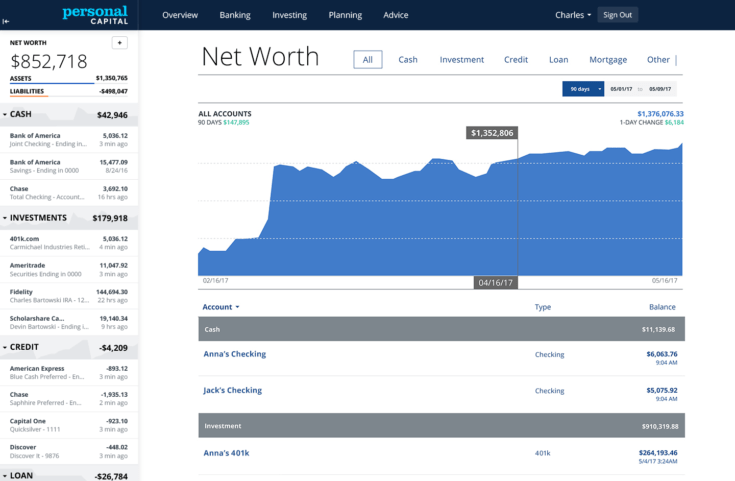
How We Use It: Due to swings in the stock market, net worth can vary greatly from day to day. Instead of riding the emotional highs and lows of the market, we look at our net worth about once a month or so, just to make sure we are staying on track. For us, building wealth is a marathon, not a sprint.
Retirement Planner
Personal Capital also offers a fantastic retirement planning calculator. With this tool, you simply set your retirement goals and measure whether your financial plan is on track to meet them. It’s a pretty cool feature, and – again – it is completely free!
The Retirement Planner isn’t just a simple calculator, though. It also helps you plan for big expenses (like college, weddings, etc.), income events (like raises and social security payments), and it helps analyze your spending and savings habits. So yeah, it’s pretty powerful.
Here’s a sneak peek at how it looks:
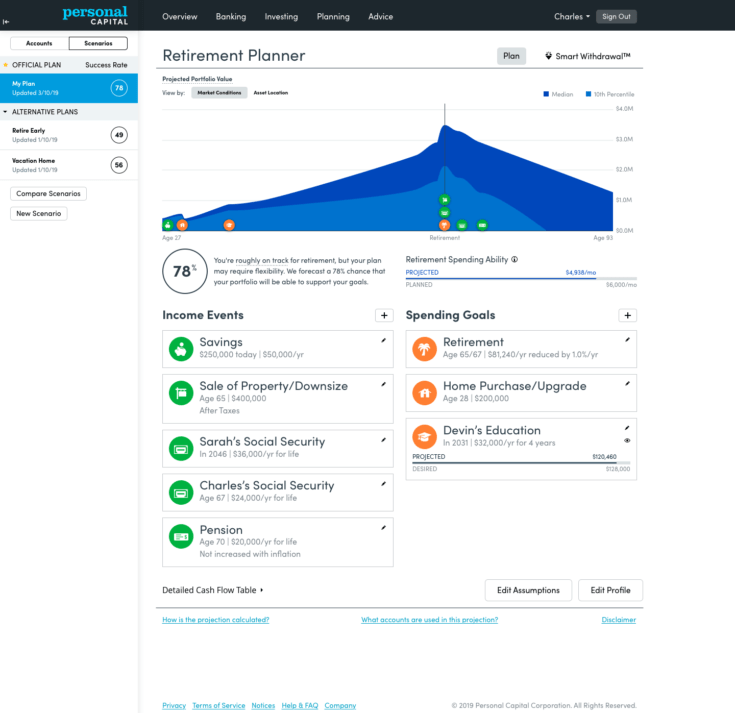
How We Use It: The Retirement Planner is another tool we use on a regular basis. It’s a great “big picture” tool that is perfect for comparing your current level of savings with your stated goals. As I mentioned, you can also use this to ensure your savings is on track for other big expenses, as well.
Seize Control of Your Money – Track your most important financial information all in one place. Get started with Personal Capital’s free financial tools here!
Savings Planner
Personal Capital’s Savings Planner tool is one of our favorite features in the entire suite. This tool makes it easy to see how much you should be saving to meet your goals. It also breaks things down by savings category (including retirement, education, emergency fund, etc.), so you can quickly track and compare whether you are saving enough to meet each individual goal.
The Savings Planner tool is a great compliment to the Retirement Planner tool. Additionally, if you decide to become a wealth management client, the Savings Planner easily converts to the Smart Withdrawal Planner after you retire.
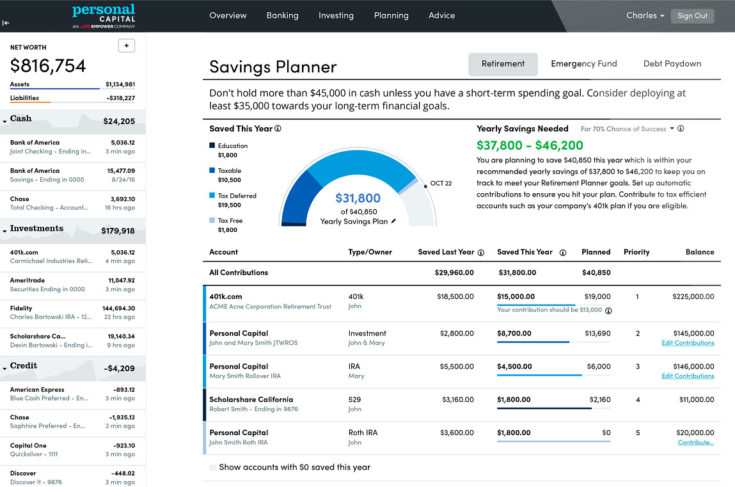
How We Use It: This is another tool that should be used on a regular basis. Generally, it’s a good idea to check in with this tool at least once a month to ensure you’re on the right savings track. It can also provide a motivational boost when you need it!
Investment Checkup Tool
The Investment Checkup Tool is another powerful addition to the Personal Capital lineup. After linking your accounts, this tool performs an analysis on the success of your investments. Then, it generates ideas for how they could do even better. You’ll even get a customized investment plan based on your current portfolio holdings and stated goals.
Specifically, the tool creates a target portfolio allocation that’s ideal for your financial situation. It then compares that target allocation to your current portfolio and makes general suggestions regarding your level of risk and potential for returns.
Now, if you’re a beginner or have recently learned how to start investing on your own, this isn’t as overwhelming as it might sound. Essentially, the Investment Checkup Tool helps ensure that you have the proper amount of exposure and diversification in your investments. Here’s a quick look at what you might see:
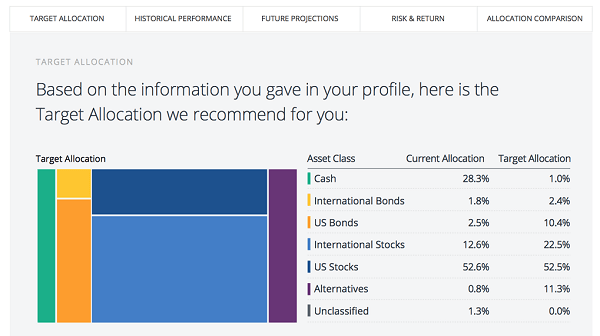

How We Use It: This is another valuable tool that we use on a semi-regular basis. As DIY investors, the suggestions about our asset allocation mix are extremely helpful. Before making any changes, we always compare Personal Capital’s suggestions with those provided by our brokerage account. When they both tell us to rebalance our holdings in the same way (which is almost always the case), we go ahead and make the change.
Investment Fee Analyzer
Although you’re going to incur costs with any investment, one of the keys to long-term growth is keeping those costs down. If you want to learn if you’re making any mistakes with your 401(k) or how much your current retirement accounts are costing you, this is the tool for you.
Personal Capital’s Fee Analyzer searches for hidden fees and shows you how much they’re costing you over time. It clearly exposes how much each investment is costing you and explains how those fees affect your retirement savings.
Here’s what the Fee Analyzer looks like:
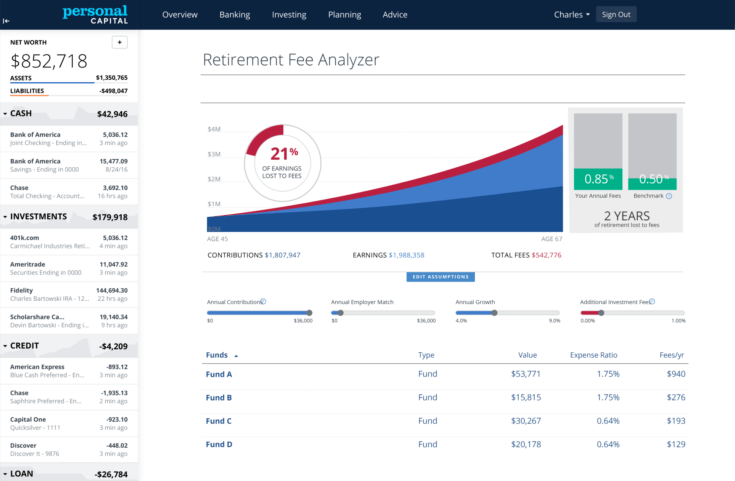
How We Use It: This tool is super valuable if you have a work-sponsored retirement account or you use a financial advisor. Rather than blindly shoving money into your retirement accounts, the tool plainly lays out what those investments are costing you. You can use that information to adjust your retirement savings strategy as needed.
Cash Flow Calculator
Last, but not least, is Personal Capital’s Cash Flow tool.
To get ahead (and stay ahead) with money, it’s important to know how much you have coming and going. Unfortunately, tracking this stuff can be a total pain, especially if you’re doing it manually. That’s where Personal Capital can give you an advantage.
The Cash Flow tool makes it easy to see where you stand by automatically tracking your deposits and spending. Once you link all your accounts, every transaction is recorded in real time. Personal Capital even tracks and categorizes each transaction for you. You can view each transaction by category, merchant, or date, making it super simple to see exactly where your money is going.
Frankly, the Cash Flow tool is a huge time saver. Keep in mind, though, that the tool has limitations and shouldn’t be used as your sole budgeting or expense tracking tool. Instead, it’s best to use Personal Capital with another budget specific program. Or, you can learn how to create a budget here.
Anyway, here’s an idea of what the Cash Flow overview looks like:
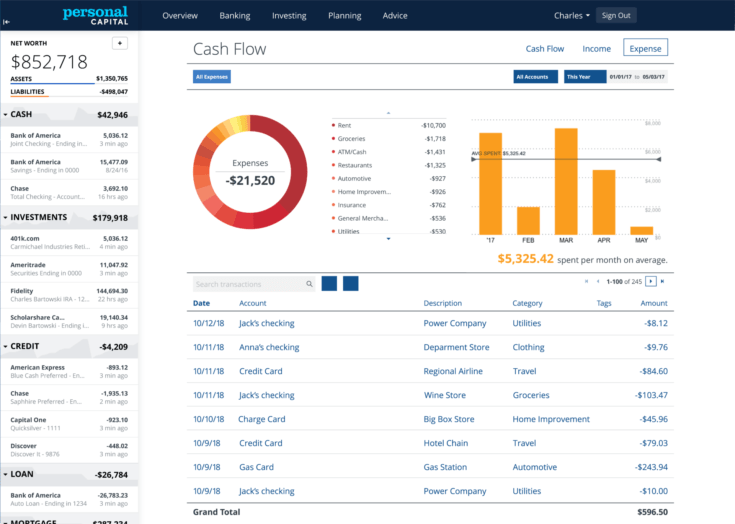
How We Use It: Although we wouldn’t necessarily using this as your only expense tracking tool, it does provide some good information. Since we typically pay for everything using credit cards or online bill pay, the cash flow tool provides a fairly accurate double-check on how much we’re spending.
Try Personal Capital for FREE – Want to get your hands on the best free financial tools around? Get started with Personal Capital here!
Personal Capital Wealth Management
With all of these great free tools, how does Personal Capital actually make money?
Simple. They provide wealth management services.
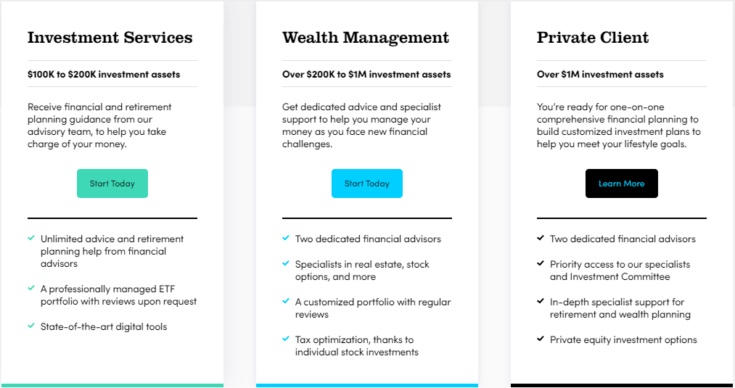
In addition to their free tools, Personal Capital offers 3 different levels of investment services based on the amount of money you have to invest. You must link at least $100,000 in portable assets to be eligible for these services.
Investors with $200,000 to $1 million in investable assets qualify to have two dedicated financial advisors working on their account. Those with more than $1 million in investable assets are eligible for Personal Capital’s “Private Client” program. At each level, fees are based on a percentage of the total amount of money you have managed. (More on fees below.)
Again, it’s completely your choice whether you join Personal Capital’s wealth management program. You make the call. Even if you don’t join, you can still use the tools for free, no questions asked.
Personal Capital Wealth Management Fees
If you participate in the Personal Capital wealth management program, you’ll be charged a fee based on a percentage of the total balance you have invested through them. As of September 2018, the fees are as follows:
Investment Services & Wealth Management Client Fees
- First $1 Million Invested: 0.89% annually
Private Client Fees
- First $3M Invested: 0.79% annually
- Next $2M Invested: 0.69% annually
- Next $5M Invested: 0.59% annually
- Over $10M Invested: 0.49% annually
Once again, this is an optional service. Using their financial tools is completely free, regardless of whether you choose to invest with them.
Benefits of Using Personal Capital
- Free Financial Software – As we’ve outlined above, the financial tools at Personal Capital are as powerful as any tools you’ll find. Best of all, they are completely free.
- Complete Financial Picture – With the Personal Capital dashboard, you can see all of your most important financial information in one place – which is great for tracking your overall financial health. For a more detailed analysis, simply click on the individual tools.
- Automatic Tracking – By linking your accounts, Personal Capital automatically tracks the most important aspects of your financial life. In addition to being convenient and saving you time, it also improves the accuracy of your tracking.
- Simple to Use – Linking your accounts couldn’t be easier, and you can get started in minutes. Additionally, the graphs and charts within each tool are exceptionally easy to read and understand, even for novice investors.
- Variety of Apps Available – In addition to its desktop programs, Personal Capital is also available on iOS and Android.
- Socially Responsible Investing – For those utilizing Personal Capital’s investment services, the company recently released their new “Socially Responsible Personal Strategy.” This service is designed to help those clients who want to invest in companies that are deemed to be “socially responsible.”
Disadvantages of Personal Capital
To be perfectly honest, there isn’t a lot about Personal Capital that I dislike. When it comes to the free tools, we’ve got no complaints. The tools really are free, and you’re under no obligation to purchase anything.
With that said, you may be contacted about investing your money through the company. We’ve never found the calls to be overbearing, and a simple “no” is all it takes if you’re not interested.
When it comes to the investment services side of the equation, Personal Capital’s fees are higher than you’ll find with a true robo-advisor but are relatively on par with other fee-based advisors. They are also all-inclusive, so you don’t have to worry about any hidden fees.
In our opinion, those with less than $200,000 in investments may be better off with a robo-advisor like Betterment. However, if you have more than $200K in investments and want more personal interaction, getting 2 dedicated financial advisors for a relatively low fee is pretty darn good.
Personal Capital Review: The Verdict
Here’s a shocker: We absolutely love Personal Capital’s free financial software.
I’m not exaggerating when I say that Personal Capital has the best free financial tools around. The tools are simple to use, easy to understand, and they are completely free! While I wouldn’t use them as my sole budgeting system, they work extremely well in conjunction with other budgeting programs or a personal budget you’ve created on Excel.
Since you’re under no obligation to use their wealth management services, I don’t see any reason why you shouldn’t open a free account right away.
We use them. We love them. We think you will too.
Get Started with Personal Capital – Like what you see? So did we. Start tracking your goals with Personal Capital’s free money tools! Learn more here.
Personal Capital Review
-
Tools and Resources
-
Commissions & Fees (Tools)
-
Commissions & Fees (Investments)
-
Ease of Use
-
Mobile App
-
Customer Service
-
Investment Options
Overall
Personal Capital Review Summary
Personal Capital is a wealth management company that also offers the best free money tools available. The tools are simple to use, easy to understand, and completely free!
Some top features include the Net Worth Tracker, Retirement Planner, Savings Planner, Investment Checkup Tool, and 401(k) Fee Analyzer. Although I wouldn’t use Personal Capital’s tools as my sole budgeting system, they work extremely well in conjunction with other budgeting programs or a personal budget you’ve created on Excel.
In addition to their free tools, Personal Capital offers 3 different levels of investment services based on the amount of money you have to invest. You are under no obligation to use their wealth management services, and using the tools always remains free.
Personal Capital’s wealth management services are a solid fit for investors with a high net worth. With that said, for anybody interested in building real wealth, we highly recommend their suite of free money tools.







I just recently set up my Personal Capital account and I’m really liking it so far. Oh yeah and it’s free!
Heck yeah it is! We love it.
I really like the retirement calculator and how you can add so many variables. It is a little annoying when advisors call, but since I haven’t shown interest, they rarely do anymore. Overall, a great product.
The retirement calculator is freakin’ sweet. We use it all the time. If you just tell the advisors you don’t want to do it, they tend to be pretty respectful. In my experience, they don’t want to waste their time chasing leads that aren’t going to convert just as much as you don’t want them to bother you.
Another reminder that I need to get started with Personal Capital! I haven’t been very interested in tracking my net worth this year since I know it’s in the negative, but that’s no excuse and it’s good to know where you are at.
It is what it is, right? As long as it is moving up, that is what we want to see!
That’s a pretty impressive array of items. I like the fee assessment tool. I need to switch my IRA to Vanguard to lower the management fees. Maybe if I get the fee information, it’ll motivate me more!
Vanguard definitely has some great management fees. If you’re somebody who doesn’t like to mess with it, check out some places like Betterment or Wealthfront too. (Shameless plug: We have some affiliate links in the Helpful Tools> “Favorite Resources” section 😉 )
I just started using Personal Capital and am impressed with the feature set, lots of good tools so far and I’ve only been playing with it for three days.
It’s pretty great stuff. We’ve been using it for a few years, and we love it!
These financial tools all look great but I personally have trust issues about sharing personal financial information with third parties. Not a big fan of them, but I do know people like me would miss out in great features. I would much rather open up a spreadhseet and start typing away 🙂
I used to be the same way. But, at this point, everything is so interconnected I’m not sure it matters any more. Plus, I try to make sure anybody I give my info to has the best security available.
Great review Greg, I’m a big fan of Personal Capital too! I’ve been using it for the last 6 months and now instead of having to check multiple accounts it’s easy to see it all in one place.
Thanks so much! I really love the ease with which you can see all kinds of important info right from your dashboard. Plus, I really love the cash flow tool 🙂
I love Personal Capital too! It’s the first online tool that has taken all of our accounts (some of the competitors couldn’t link to everything!) And the graphs and charts – well, I’m a geek for those too 🙂
Yeah, if you’re a stat geek like me, the graphs and charts are totally fun 🙂
Thanks for the review. I am leery to use them because of having my financial information all in one spot, thus making it catastrophic if you get hacked or your identity stolen.
Hey Chris,
That’s a valid point and one I failed to address in the review. On one hand, I’m always leery about providing financial info to third parties. On the other hand, Personal Capital only allows you to see your account balances. You can’t move money around using the app, so nobody can hack in and steal directly from your PC account. They are also forced to comply with SEC regulations regarding online security, so they are basically treated like any other online broker.
That being said, I’m not sure that anything these days is completely 100% safe. Everything is connected online, including brick and mortar banks.
Great review! I like that you covered all the major points and address concerns people might have about it. Great work!
Thanks for the review! I need a place to track all my investment and how much it’s costing me in fees. This will really help, and once I use less cash, I can automate more. Yay!
Yay! I have now a Personal Capital account and it’s free. I hope that this makes an impact on how I budget and manage my money. Thanks for the review Greg.
Any security concerns linking your accounts to this?
Hey Kevin,
None that I know of. You can’t actually move money around with the app, so nobody can hack and steal directly from the app. They must also follow SEC regulations on security. They have a brokerage branch as well. I’m not a security expert though, so you should definitely check with them if you have more questions.
Thanks for your help! I’ll check it out!
I don’t have any concerns, no. They list detailed security information on their website and I feel comfortable with all the steps they take to keep information safe.
Thank you for your comprehensive article. I am a longtime Mint user, but there are numerous things about Mint that I don’t love. I’ve been considering using Personal Capital for some time, but I’m concerned that I would be subjected to numerous sales pitches. My wife and I already work with a financial advisor with whom we’re pleased, and we have no interest in switching. Thanks for your experience.
Hey Helen,
Mint is a great tool as well, but I really love Personal Capital. Of course, there is no reason you can’t use both 🙂
Honestly, they don’t bother you much at all. You can expect maybe 1 email and 1 phone call every year. If you say no, they are totally fine with that. So, if you’re looking to try it out, the program is free. I’d give it a shot and see what you think.
Hi,
Are there any software programs that you recommend for use in Canada? I really like the idea of what personal capital is but do not want to use an online service.
My credit union isn’t on the list and therefore can’t be linked!! So will this part even be worth it, manually entering every transaction, or is it time to go to a bigger institution? If so, who do you recommend??
Thank you for your support!
Thank you for the tool introduction! However, there is no way I could risk to link my financial accounts to it (yes, I did read all the earlier comments). Do you know a good financial tool that would allow one to import the statement spreadsheet files manually downloaded from bank sites instead of linking accounts?
Thank you!
Hey Jim,
Here is a list of 10 of our favorite budgeting apps: https://clubthrifty.com/best-quicken-alternatives/. Dollarbird and Everydollar (#9 & #10) may be more of what you’re looking for. If you don’t want to link accounts, the other option would be to just create your own spreadsheet. Hope that helps!
Very helpful review of Personal Capital! I’ve been using Personal Capital (PC) for the last few months and really like it. The Dashboard and Investing tools are very insightful and easy-to-use. I’ve also signed-up for asset management services and have found my advisors very helpful in developing a comprehensive financial plan.
One area I’m still trying to make the most out of is cash flow and budgeting. I’ve been budgeting down to the dollar for years using various tools (Excel, AnMoney, Mint, YNAB, and Learnvest among them). I’m still using Mint in conjunction with PC as I find Mint’s budgeting tools more comprehensive. Specifically, the ability to set a monthly budget amount for various categories and track to that amount. For example, if my monthly “Grocery” budget is $500, I can specify that in Mint and see how much I’ve spent against that $500 limit in the “Budget” tab. I haven’t been able to replicate this functionality in PC. I’m able to set an overall monthly budget (e.g. $5,000) and see how my overall spending compares against that amount, but haven’t figured out how to do it at the Category level.
Is anyone else who uses PC able to budget by category and figure out how much they’ve spent against each category’s budget? Being able to do this in PC would mean I no longer have to do double-entry in Mint.Thanks!
Do any of these sites allow you to combine accounts for a married couple? My wife and I both have our own amex/chase/etc logins and I know for sure Mint doesn’t let you add the same institution twice with different logins. I have yet to find something that I don’t have to use twice (once for my accounts, once for hers) and then combine on my own.
Well now I feel dumb. After posting that I realized I haven’t tried adding two of the same site logins and it looks like you can. Any suggestions on other sites you can use jointly? I assume you use Personal Capital this way and still recommend it?
Hey there and thanks for reading 🙂 Here’s a list of several different programs that you might like: https://clubthrifty.com/best-quicken-alternatives/ Hope that helps!
Nice review. However, i didn’t see anything about adding tangible assets…income-producing real estate, art, rare coins, what-have-you? Can those be added and tracked?
Hi Darrell,
Yes, tangible assets can be added in Personal Capital. You can either link accounts or have the option to “Add Manual Account”.
On the Add Manual Account screen you can choose from several asset types including, Home, Car, Jewelry, Art, as well as Other Asset and Other Liabilities, among others. For a Home, you can even choose to link it to Zillow to have your home value in PC reflect your current Zestimate. The other types simply allow you to enter a Description, Current Value/Balance, and Account Number.
Any Manual Accounts you add show up in the “Other Accounts” section in your summary and are included in your Net Worth calculation.
Hope this helps!
Personal Capital wants to link accounts to their dashboard and download transactions. It does not allow (as of this writing) a person to manually enter transaction data. My Credit union does not allow for downloading transaction information. This makes Personal Capital unusable for me.
I like the took and use it quite a bit, but the Cash Flow tool is very frustrating. While using it I often see things that I want to recategorise or otherwise change. It constantly refreshes while I’m trying to do this. Also, it needs better keyboard navigation. It’s so close, yet far enough away as to be really vexing. I contacted their support team but got a meaningless response about how they are unable to work on the Cash Flow section at this time.
Does the software generate financial statements?
No, it does not.
I am interested in using Personal Capital. Can I add in irregular expenses that I know I will have in the future into the cash flow section?
Does it have a checking account setup; e.g. a register-like format setup to manually write check pmts. etc. credit card online accts., etc
Thanks for the thoughtful and thorough review. I’ve used the granddad (Quicken) for decades, literally. Q’s recent moves and now forcing users into a subscription-based program prompted me to look around.
I have a couple of concerns. I am not (yet) comfortable with all my financial world being stored on a server instead of my hard drive. I’m not “unconcerned” now, but am resigned that everything is moving that way. Unless I’m going back to Excel or paper, I’d better find one I trust. The second is a tool Q calls “savings goals.” Does PC have anything like this? Savings goals are like virtual accounts (or envelopes), taking their balance out of the ledger their saved in. (Hope that makes sense.)
Sounds like a great program. I have used Quicken for years and years….no longer. I just want to track checking and credit card accounts and b alances. No stock stuff, but it might be interesting to use. I wonder if quicken files will transer to this program.
is it possible to upload historic checking account transactions as my bank only goes back 90 days for online items…
I am concerned about the safety of all of my information being stored online. If someone was to hack into my personal capital account, would they then have access to all of my accounts through it?
In short, no – it shouldn’t be a problem. In addition to their encryption practices, you can not make any transactions through Personal Capital’s software.
I have been a happy Quicken user for over 15 years. Is Personal Capital able to import my existing Quicken files? Also, another poster mentioned that entering transactions manually is not possible with PC. Is this true? Those would be the two deal breakers for me as I consider alternatives to Quicken. Thank you.
Was looking for an alternative to Quicken. Mostly the monthly expense reports. After several back and forth emails, was dismayed to learn that monthly reports max out at 50 transactions. I don’t know why 50 is the magic number, but I far exceed that. I other wise liked the software. Too bad I can’t use it.
I would like to see your comments on transferring from Quicken. I am getting unhappy with the errors I have getting with data downloading and reports with Quicken they don’t support it as well after Intuit sold Quicken.
I have used Quicken 7 to manage my rentals but am being forced to a membership that I don’t feel will work for my personal and my rentals. Is there a software that can help me?
Hello, Greg, My wife owns a Pilates Studio and when she adds Bank of America to PC all her business accounts are also added. Is the best option to remove the business accounts all together or mark as closed as I do not see an option to hide?
Your reviews are excellent — professional, insightful. Questions, please: 1. what is best tool for tracking expenses including splitting credit card charges into categories (like Quicken), bill payment, etc. since I do not need the investment tracking piece of Personal Capital? 2. And is there such a tool that enables me to import my Quicken data into the new tool?
Thanks for your reviews. I will surely try to using this soft ware to track my credit card charges.
Thanks